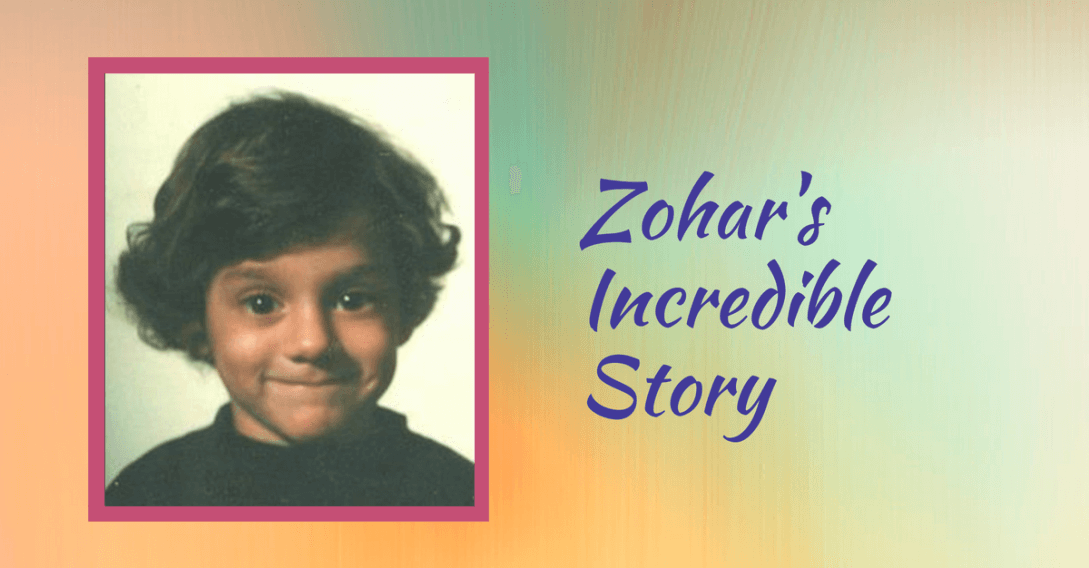Zohar’s Incredible Story: The Feingold Diet
SHULA EDELKIND
Zohar was an active and happy baby. As a toddler, he developed an asthmatic cough, and his teacher at daycare in Israel commented that if he wasn’t on top of a table within five minutes of arrival, she knew he was sick. This was not, at the time, considered a problem.
He was known to be allergic to the baby aspirin given for teething, but nobody mentioned salicylate in foods, or that coloring in drinks or food could be a broncho-constrictor.
Actually, the diet in Israel in those days contained lots of fresh fruit and very little food dye or preservatives. They never even heard of frozen orange juice back then; the response to my quest for juice was “squeeze an orange.”
Nigeria and the USA made things worse
Symptoms escalated when we lived in Nigeria, where I was putting red food coloring into sweetened powdered milk because we could not get fresh milk. There, he started running in circles and (literally) climbing walls. Arriving in the U.S. at age four, he was a puzzle, with screaming tantrums many times a day, and rolling on the floor out of control.
I never placed any importance on the difference between the mostly natural diet he’d had in Israel, and the much more “advanced” American diet. (Note: This was in the 1970’s. Today the Israeli diet is similar to ours, a change that has accompanied an increase in ADHD, asthma, etc. in Israel.)
Finally, by first grade he was diagnosed with “hyperactivity with extreme mood swings.”
Zohar also had asthma and was frequently sick with strep throat and ear infections. Starting at six years old, medication (Ritalin, followed by Cylert) controlled his activity levels and flattened his moods, but by seven he was at the very bottom of the height and weight chart for his age. He had also begun having hallucinations. (The hallucinations turned out to be a side effect of Cylert, but we could not know that until the medication was later stopped.)
Should we add an anticonvulsant?
Our son was in an expensive school where he was taught by specialists in ADHD. Summer day-camp asked him to please not come back. Although we had been going to the neurologist every month for years, Zohar was just getting worse. The addition of Tegretol (an anti-seizure medication) to the Cylert was prescribed to control the hallucinations. The specialists presumed these were seizures, in spite of negative EEG tests.
As I hesitated to add this medication, with its long-term side effects, my doctor assured me it was “no more dangerous than crossing the street.” (Not a good thing to say to a mom whose kid was hit by a car at age 2!) Before I had made any decision about the Tegretol, he started having 30 different motor and vocal tics, and the neurologist took him off all medications. That was back in 1983 when Tourette Syndrome (TS) was a little-known disorder, so it wasn’t even diagnosed for a year – the Year From Hell.
Rising up from a year in hell
At this point I had an 8-year-old child who looked like he was possessed. He was not in control of his body, his emotions, nor his thinking. Zohar would read, often upside down, repeating phrases several times as though a record were “stuck,” and he could barely write a word at a time. He inserted the word “smurf” in every sentence. Yet he could do advanced math in his head, and testing had shown he could arrange blocks from pictures at the hardest adult level. Nothing made sense.
My boy had no friends. What kind of future was he facing? I learned of the Feingold diet on a TV talk show, but when I asked my doctor about it he told me not to bother because it “only worked for 2% of kids” and he said it would be hard. But since I had no other treatment available, I decided to try it anyhow.
To my surprise, in four days I had a child with normal behavior. He still had the tics, but I didn’t expect that to change since it is supposed to be incurable.
It soon became apparent that Zohar no longer had ear aches, no longer had asthma–and by the end of the year he no longer had any Tourette symptoms!
Tourette’s has been in what his ex-neurologist calls “permanent remission” for over 20 years, except for the few times when he went off the Feingold diet for any length of time.
As a teen, he was voted “most popular counselor at a day camp. “Remember, this is the same child whose previous behavior did not even allow him to go to camp!
No longer in “special” classes, he graduated from Yeshiva High School (a tough school with half-day Hebrew studies), achieved the respectable height of 5’8″, and went on to college at Emory University. In college, his dorm room was always full of friends (and they liked his cooking).
Excelling as an adult
Zohar graduated as a chemistry major with a solid B average, and as president of the Emory Fencing Club. When exposure to chemicals in his first job in a chemistry lab triggered a recurrence of the old asthma, he quit chemistry. After teaching high school math for three years, he went back to school for a degree in mechanical engineering.
He’s been an engineer now for several years, is married, and has two adorable children, both on the Feingold diet since before conception.
One of my proudest moments was when he called to tell me he had received his first job review, and his boss had complemented him on his great organizational skills!
In the early 1990s, Shula Edelkind became a volunteer for the Feingold Association (FAUS). She also went back to school, majoring in Bio-Psychology. She created the Feingold Association’s internet presence (www.Feingold.org), and an email HelpLine. Shula also began building a library of research on the relationship of diet to ADHD, autism, asthma, and eczema on her own website.









